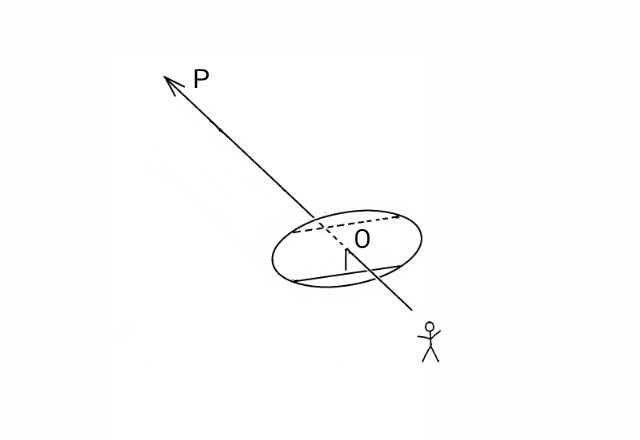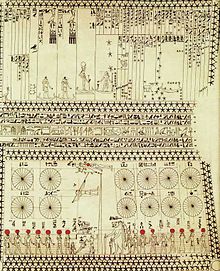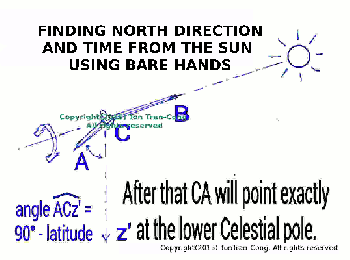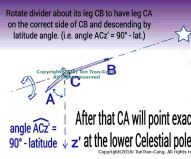Time keeping without using watches
by tonytran2015 (Melbourne, Australia).
Click here for a full, up to date ORIGINAL ARTICLE and to help fighting the stealing of readers’ traffic.
(Blog No.84).
#find North, #find time, #finding time, #time keeping, #timekeeping, #shadow stick, #star disk, #aiming rod, #equatorial mount, #sundial, #true North.
Time keeping without using watches.
Whenever an expedition camp is set up there is always a need for time keeping in the camp. Time keeping is required to get everyone back to base at the same time for meals or for camp activities. In the Eastern World, people had practiced reasonably accurate time keeping WITHOUT USING WATCHES since more than 2000 years ago. Their technique has been fairly accurate and is explained here so that it can be appreciated and be useful to modern campers when separated from their watches.
1. The vertical shadow stick for finding time and finding North.
In the old-time in Eastern World, each castle has a time-keeper. It is interesting to learn the tricks of such a timekeeper. His main instrument is the vertical shadow stick the operation of which is described here
Figure: A shadow stick for finding North and time is drawn here in blue colour. The shadow of its tip always move WEST TO EAST along a conical curve C (drawn in red). The shadow of the whole stick is a straight line joining its base to the shadow of its tip on the curve C. The axis of symmetry of the curve C is the terrestrial North-South direction.
A. The timekeeper/navigator first sets up a rigid vertical rod firmly buried in a level ground. The movement of the shadow of its tip gives time as well as directional information. That is it tells both time and the North-South direction.
B. He then draws many concentric circles on the level ground around the base of the stick. He then marks the position of the shadow of the tip on the ground, joining them to make a curve (which can be shown by geometry to be a “conical curve”). The symmetry axis of this curve is the true North-South direction at the location and the point on the curve closest to the base of the vertical stick corresponds to Local Noon (which differs significantly from Zonal Noon due to difference in Longitude and the variable speed of the Sun on the Celestial Sphere, the effect of the latter is known as the effect of the Time Equation). The shadow of the tip always moves WEST TO EAST and does so accurately near to NOON. Near to noon the shadow of the tip moves Eastwards by a distance of 1/4 of its distance to the tip every hour.
The timekeeper/navigator gives daily instructions to camp inhabitants on the time to come back to camp for meals/activities. The time for coming back is selected by his predetermined ratio of the length of the vertical stick to that of its shadow. When leaving the base camp, each inhabitant has to make his own portable vertical stick to keep track of the approaching time for returning to base.
C. The vertical stick has a drawback that is the shadow of its tip travels at non-constant speed on a curve that changes slowly during the year.
One example of the disadvantages of the vertical shadow stick is that it cannot help dividing daylight duration into six intervals of equal duration for guard duties.
D. Equal intervals of time are determined from burning incense sticks, reciting prayers, filling containers with dripping water, boiling water pots, etc… Near to noon the shadow of the tip moves Eastwards by a distance of 1/4 of its distance to the tip every hour (During one hour the Sun moves along an arc which is nearly 15 degrees long and sin 15° is nearly 1/4.).
2. Star disk for time keeping at night.
Time keeping at night can be carried out accurately using the stars.
Any star-gazer (ancient timekeepers/navigators had to be star gazers) in temperate zones can easily see that all stars on the Celestial sphere rotate around the stationary Polar star (when observed from Northern hemisphere) or a stationary black point (from Southern hemisphere). It appears as if all circumpolar stars have been stuck on a heavenly disk pivoted on the Celestial pole in the sky and the disk rotates slowly during the night.
The stars have certainly been drawn on an Egyptian Senenmut star map since before 1473BC (https://en.m.wikipedia.org/wiki/Astronomical_ceiling_of_Senemut_Tomb)
Figure: The double wall mural of the tomb of Senenmut, (https://en.m.wikipedia.org/wiki/File:Senenmut.jpg), the image has been released into Public Domain.
on China Suchow map about 1190BC, and on walls of tombs in the land of present China, wiki, Chinese star maps
Figure: Suchow map, from Wikipedia. Used under Common Creative License conditions.
The rotation of the disk can be used to tell time. The rotation seems to be at constant speed as equal angles of rotation seem to always correspond to the same duration of time for burning incense sticks, reciting prayers, filling containers with dripping water, boiling water pots, etc…
Figure: A circular disk with the drawing of bright Northern circumpolar stars as well as other bright stars visible in the sky.
To tell time accurately, the time-keeper can draw the bright circumpolar stars (including the Little and Big Dippers) on a paper disk, hold the paper disk in the direction of the Celestial pole in the sky and rotate the paper disk to align the drawing to the actual star. The slow rotation of the paper disk indicates the passage of time. The accuracy of the method depends on the size of the disk and the accuracy of its alignment to the real stars in the sky.

Figure: Aligning the center of the paper star disk to the Celestial pole in the sky to determine its rotation during the night.
This method does not require the determination of meridional crossing of dim stars. Ancient time keepers may have used this method to keep accurate time at night using only bright stars..
3. Time divisions by meridional passing of selected stars.
A star makes a meridional passing when it passes the vertical plane in the North-South direction. That is when it is vertically on top of a wire strung in the North-South direction.
A time-keeper may use the meridional passings of selected stars as markers for division of time (into many known recorded unequal parts) during night-time.
Based on those markers a time-keeper can divide the night into nearly equal intervals.
4. Improved Star disk for time keeping at night.
A bigger disk can be aligned more accurately, its rotation can be more accurately measured, but is harder to be held up in the sky. Making a bigger disk mounted in air for improved accuracy is therefore an expensive design.
Figure: A star disk on equatorial mount on the ground, to be read from its upper surface.
A better design is presented here and it is to make a big star disk on equatorial mount so that it will be parallel to the paper disk in the air but is mounted on the ground like a tilted round table top, with an aiming rod mounted at its center pointing to the Celestial pole. The star map engraved on the big disk here is a mirror reflection of the image of stars in the sky. An imaginary observer underneath the disk would see through it the image of the stars in the sky. Markings will be drawn accurately on the rim of the big disk for the positions of the engraved stars (which are drawn for a designated night of the year). There will also be regularly spaced markings for measuring the rotation of the observed stars from their engraved standard positions. A time-keeper will only require access to the upper surface and the rim of this large star disk mounted on the ground.
Figure: A star disk for installing on an equatorial mount on the ground. The map here is a mirror reflection of the image in the sky. This disk is aligned for September Equinox.
With this type of large star disk and its central aiming rod, a time-keeper can tell where a star is relative to its position engraved on the disk. The disk is engraved with drawing of the stars on one designated night which may be either the spring equinox night or the winter solstice night.
The spring equinox night has the advantage of accuracy of date in the year, it is the night when the Sun rises and sets exactly in the East and West principal directions. The winter solstice night has the advantage of having the longest duration to observe stars.
On the designated date for the disk, the rotation of any star from its engraved position directly gives the time from midnight. On any other night an offset can be worked out using only a string placed along the perimeter of the circular disk. For every night subsequent to the designated night the stars move forward by nearly 1/365 of the perimeter.
5. Star disk for time keeping in the day.
The nights with partial Moon show that the Moon moves around the aiming rod at nearly the same speed as the stars. The days with partial Moon also show that the Moon and the Sun move around the aiming rod at nearly the same speed.
Therefore any time-keeper with an inclined star disk will find that the Sun, the Moon and the stars all move together around the aiming rod with nearly the same speed. This would lead to his use of the inclined star disk for time keeping, with the advantage that the shadow of the aiming pole moves on the rim of the inclined disk at constant speed! So the inclined star disk also work as an equatorial mounted sundial (meaning the sundial disk is parallel to the equatorial plane.).
(This knowledge has given rise to the description of Solar position in the Zodiac. The shifting of the Zodiac by precession shows that the association of solar position with the Zodiac has begun thousands of years ago.)
So far I had been able to find only equatorial mounted sundial with no engraving of stars. One such a sundial can be seen in Beijing. This disk has only time markings and can be read on both sides.
Figure: A sundial in the Forbidden City, or Imperial Palace, in Beijing. https://commons.wikimedia.org/wiki/File%3ABeijing_sundial.jpg, Date 26 February 2003, Author User: Sputnikcccp~commonswiki .Figure used under the Creative Commons Attribution-ShareAlike License.
During Winter months, a flat cardboard can be used to find the intersection of the shadow of the aiming stick and the rim of the large disk if it has no accessible lower surface.
Using the equatorial sundial during the days gives the advantage of fast determination of time with no required large seasonal adjustment. With the help of an equatorial mounted sundial, a time-keeper can divide time into any number of equal intervals and can also work out the ratio of a vertical stick to its shadow at any time of the day.
6. Timing wires used in remote areas.
Similar to the central rod of an equatorial mounted star disk, any taut wire strung parallel to the Celestial axis can be used to time intervals of 24 hour. The shadow of such a wire under a strong Sun comes back to its previous position after every 24 hours. Clock makers in the 1800’s, when radio receivers were not widely used, have been using this trick to time the clocks under their repairs .
7. Time keeping with an unclear sky.
Burning of incense is used to complement time keeping using star disk in days of poor visibility.
Time keepers have incense sticks for short-term timing or incense coils which last up to three days for long-term timing.
Time keepers also have other methods for timing, they are reciting prayers, filling containers by dripping water, boiling water pots.
On ancient ships, time keepers can count repetitive actions such as the rowing cycles of oars, the food items made by a kitchen, etc…
8. Announcing time to surrounding area.
The time-keeper may use drums or low pitch horns to announce the time to his surrounding area.
On receiving the signal for time, surrounding institutions such as nearby pagodas synchronize their own activities and then may sound their own gongs as secondary level time signals.
The population around the castle use these time signals to open their shops, prepare their predawn cooking etc…
The whole community relies on those signals to synchronize their interacting activities.
9. Natural time keepers.
There are natural time keepers, they are the animals and plants in the areas.
Certain types of birds tweets ar some fix time intervals before sunrise. Each type of tweets has its own fix interval before sunrise. The tweets by different types of birds follow one another in the same sequence every day.
Chickens’ roosting have been used as reliable time signal foe imminent sunrise.
Chameleons’ croaking have sometimes been used by some people in Vietnam as reliable Noon time signal.
There are some plant flowering at some certain time during the day. The Vietnamese plants “HOA MƯỜI GIỜ” (meaning “Ten o’ clock flowering plants”) flowers at a constant time near to 10 AM.
References.
[1]. tonytran2015, Shadow-stick-navigation-and-graph-of-solar-paths, posted on August 19, 2016.
[2]. wiki, Astronomical_ceiling_of_Senemut_Tomb.
[3]. Suchow map, http://www.adlerplanetarium.org/exhibits/planetary-machines.
[5]. tonytran2015, Finding directions and time using the Sun and a divider, survivaltricks.wordpress.com , Finding directions and time using the Sun and a divider., posted on May 6, 2015.
[6]. tonytran2015, Finding North direction and time using the hidden Sun via the Moon, survivaltricks.wordpress.com, Finding North direction and time using the hidden Sun via the Moon . Posted on July 6, 2015.
[7]. tonytran2015, Finding North direction and time by stars, survivaltricks.wordpress.com, Finding North and time by stars. Posted on August 28, 2015
[8]. tonytran2015, Finding accurate directions using a watch, posted on May 19, 2015 .

.
RELATED SURVIVAL blogs
Shadow stick navigation and graph of solar paths, posted August 19, 2016

, posted on 2018 July 10

Finding directions and time using the Sun and a divider., posted on May 6, 2015. <<<—This is my MOST USEFUL novel technique.

Finding North direction and time using the hidden Sun via the Moon . Posted on July 6, 2015

Finding North and time by stars. Posted on August 28, 2015

Finding North direction and time by any bright star, posted July 22, 2016
Navigating with an AM MW radio receiver, posted January 17, 2017 The Scorpius constellation, posted January 8, 2017, The Orion constellation., posted December 26, 2016, Rice as emergency food., Using GPS in off-grid situations, Slide Sky-Disks with grid masks showing azimuths and altitudes, Slide Sky-Map for displaying tropical stars.
BLOG IMAGE OF SURVIVAL CONTENTS
Click here for my other blogs on  SURVIVAL
SURVIVAL
Click here go to  Home Page (Navigation-Survival-How To-Money).
Home Page (Navigation-Survival-How To-Money).
BLOG IMAGE OF CONTENTS HOME PAGE











Genuinely no matter if someone doesn’t be aware of after that its up to other viewers that they will help, so here it takes place.|
LikeLike
I am truly glad to read this blog posts which carries tons of valuable data, thanks for providing these kinds of information.|
LikeLike
Wonderful blog you have here but I was curious if you knew of any forums that cover the same topics talked about here? I’d really love to be a part of online community where I can get comments from other knowledgeable people that share the same interest. If you have any recommendations, please let me know. Thank you!|
LikeLike
It’s very effortless to find out any matter on net as compared to books, as I found this post at this site.|
LikeLike
Have you ever considered about adding a little bit more than just your articles? I mean, what you say is important and all. Nevertheless just imagine if you added some great images or video clips to give your posts more, “pop”! Your content is excellent but with pics and videos, this site could certainly be one of the greatest in its field. Fantastic blog!|
LikeLike
I seriously love your website.. Excellent colors & theme. Did you create this site yourself? Please reply back as I’m hoping to create my very own site and would love to find out where you got this from or what the theme is called. Many thanks!|
LikeLike
I’m really loving the theme/design of your blog. Do you ever run into any internet browser compatibility issues? A few of my blog readers have complained about my website not operating correctly in Explorer but looks great in Safari. Do you have any advice to help fix this problem?|
LikeLike
I must thank you for the efforts you have put in penning this website. I am hoping to view the same high-grade blog posts by you later on as well. In fact, your creative writing abilities has motivated me to get my own site now ;)|
LikeLiked by 1 person
Thank you for the compliments.
LikeLike
I have visited your blog, it is nice.
LikeLike
Hey terrific blog! Does running a blog like this take a lot of work? I have virtually no expertise in computer programming however I was hoping to start my own blog in the near future. Anyways, should you have any ideas or tips for new blog owners please share. I know this is off topic but I just had to ask. Cheers!|
LikeLike
What i don’t realize is in truth how you are no longer really a lot more neatly-appreciated than you might be right now. You are so intelligent. You realize thus considerably with regards to this topic, produced me for my part believe it from so many numerous angles. Its like women and men aren’t involved until it’s something to accomplish with Woman gaga! Your own stuffs nice. At all times handle it up!|
LikeLike
Reblogged this on and commented:
Speaking for myself, I cannot tell one star from another in the night sky. I had tried a few times to use a sextant, but was unsuccessful.
LikeLike
Thank you, Brittius, for re-blogging.
LikeLike
You’re welcome.
LikeLiked by 1 person
Probably you can start with identifying Big Dipper, Little Dipper and Cassopedia when your sky is clear. Identifying other bright stars will follow naturally.
LikeLiked by 1 person